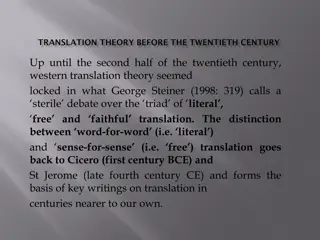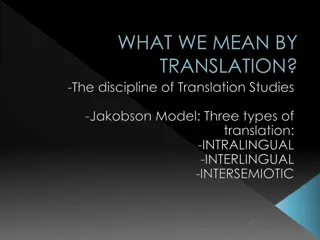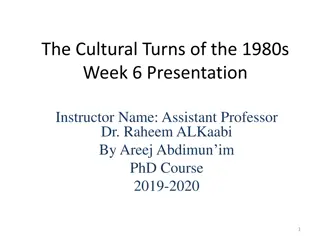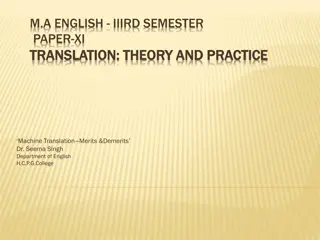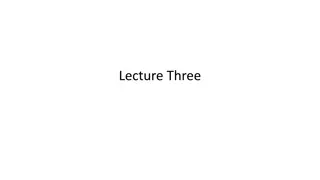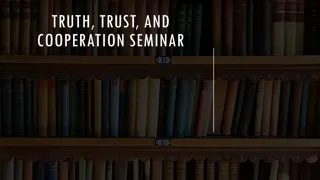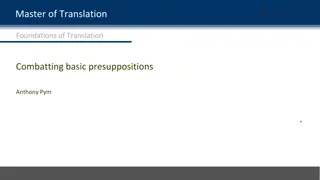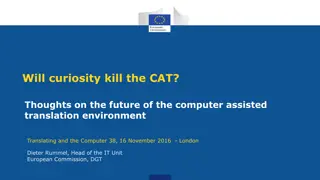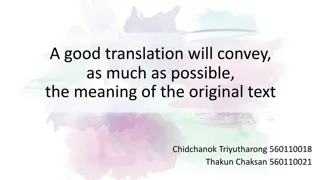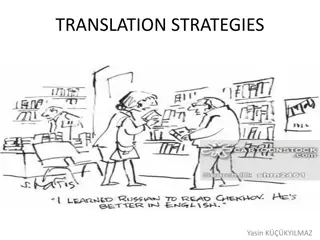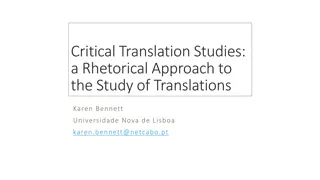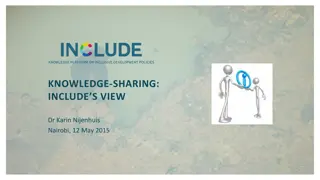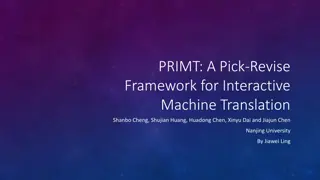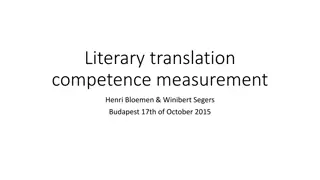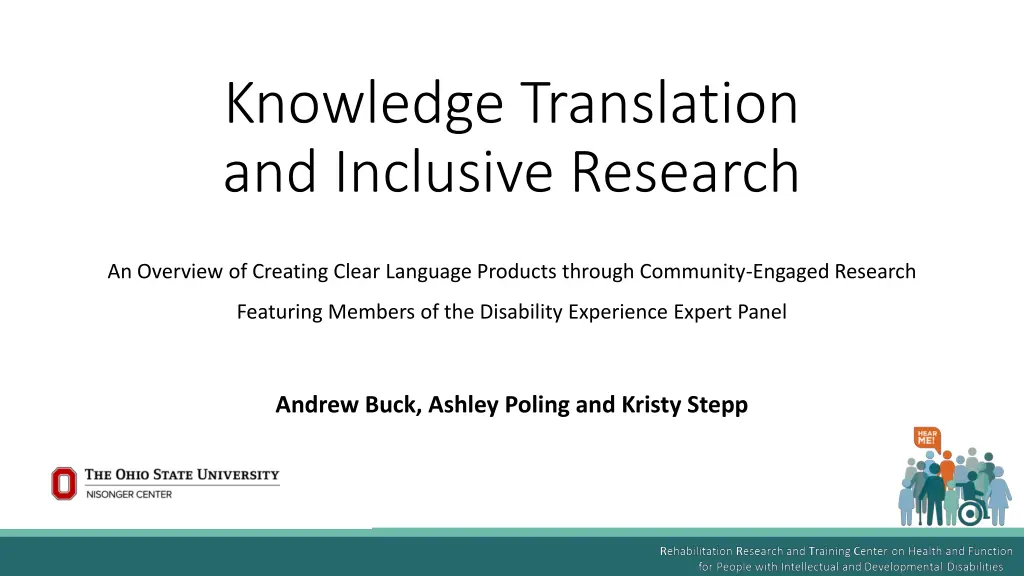
Clear Language Products: Knowledge Translation & Inclusive Research Overview
Explore the importance of Knowledge Translation (KT) in creating accessible information for all. Learn about the purpose, significance, and process of KT through community-engaged research. Discover why clear language products benefit society and how to effectively translate knowledge for broader understanding and accessibility.
Download Presentation

Please find below an Image/Link to download the presentation.
The content on the website is provided AS IS for your information and personal use only. It may not be sold, licensed, or shared on other websites without obtaining consent from the author. If you encounter any issues during the download, it is possible that the publisher has removed the file from their server.
You are allowed to download the files provided on this website for personal or commercial use, subject to the condition that they are used lawfully. All files are the property of their respective owners.
The content on the website is provided AS IS for your information and personal use only. It may not be sold, licensed, or shared on other websites without obtaining consent from the author.
E N D
Presentation Transcript
Knowledge Translation and Inclusive Research An Overview of Creating Clear Language Products through Community-Engaged Research Featuring Members of the Disability Experience Expert Panel Andrew Buck, Ashley Poling and Kristy Stepp 5/7/2025 5/7/2025 5/7/2025 1 1 1
What is Knowledge Translation (KT)? What is Knowledge Translation (KT)? KT is an iterative revision process between stakeholders that makes technical information more accessible, usable, and clear for more people. High Reading Level Knowledge Translation Hard to Access & Understand Lower Reading Level Reduce Reading Level Not Accessible or Usable for Many People Easier to Access & Understand Improve Visual Display Accessible and Usable for More People Technical Knowledge Ask Many People for Input to Make It Better Clear Language 5/7/2025 5/7/2025 2 2
What is the Purpose of KT? What is the Purpose of KT? The purpose of knowledge translation is to increase access and understanding of information, so more people can use it. 5/7/2025 5/7/2025 3 3
Why is KT Important? Why is KT Important? Everyone has the right to access, learn, and use information that helps them make important choices and live a healthy and productive life. Information that is easier to understand helps people make better choices on issues such as education, employment, and healthcare (UKDH, 2010) Studies have shown that providing clear information can save time, personnel resources, and money (U.S. General Services Administration, n.d.) 5/7/2025 5/7/2025 4 4
How Do You Translate Knowledge? How Do You Translate Knowledge? Guidelines Universal Design for Learning Give choices Use multiple media Organize information and resources Plain Language Write for your audience Use common words and shorter sentences Organize display with headings and simplify with lists 5/7/2025 5/7/2025 5 5
The OSU The OSU Nisonger RRTC Nisonger RRTC Knowledge Translation Process Knowledge Translation Process 5/7/2025 5/7/2025 6 6
The OSU Nisonger RRTC Model The OSU Nisonger RRTC Model The research project s Learning Collaborative (LC) is supported by two expert teams: REEP DEEP 1. Research Experience Expert Panel (REEP) LC LEARNING COLLABORATIVE 2. Disability Experience Expert Panel (DEEP) 5/7/2025 5/7/2025 7 7
Research Experience Expert Research Experience Expert Panel Panel The REEP is a group of leaders in disability research and policy, some of whom have disabilities. Partners who advise on technical aspects of the research process to ensure studies are rigorous, reliable, and valid Support knowledge production and write academic articles 5/7/2025 5/7/2025 8 8
Disability Experience Expert Disability Experience Expert Panel Panel The DEEP is a group of individuals with lived disability experience, many of whom have experience with the mental health system. Partners who advise on community aspects of the research process to ensure studies are accessible, clear, and inclusive Support knowledge translation to make clear language products 5/7/2025 5/7/2025 9 9
OSU OSU Nisonger RRTC KT Nisonger RRTC KT Process Process Step 2: Populate and Review KT Template Step 4: Finalize and Publish Product(s) Authors Project Staff Authors DEEP/REEP Project Staff Project Staff Authors Authors Project Staff REEP/DEEP Step 3: Draft, Review, and Develop Clear Language Product(s) Step 1: Identify Audience(s) and Product Type(s) 5/7/2025 5/7/2025 10 10
Step 1: Identify Step 1: Identify Audience(s Audience(s) and Product Type(s ) and Product Type(s) ) Authors and project staff begin the translation process after publication of an article or other technical product. The team may use the project s KT Guidelines and Template to guide the process. 5/7/2025 5/7/2025 11 11
Step 2: Step 2: Fill Out Fill Out the KT Template the KT Template Authors fill out different parts of the KT Template: Title Research Questions (e.g., Methods) Key Findings (e.g., Results) Main Take-Aways (e.g., Discussion) Why Is This Important? (e.g., Implications for Practice) The team may decide to customize the template based on audience or product type. 5/7/2025 5/7/2025 12 12
Step Step 2 (continued): 2 (continued): Review the KT Review the KT Template Template Authors may share their KT Template with REEP and/or DEEP. Supports wider teamwork to: identify challenging vocabulary and concepts discuss clear language translations of technical content brainstorm visual supports Feedback is collected to draft the clear language product. 5/7/2025 5/7/2025 13 13
Step 3: Draft, Review, and Develop Step 3: Draft, Review, and Develop Product(s) Product(s) Authors use clear language guidelines to draft product(s) Back-and-forth feedback is gained from the DEEP and/or REEP (e.g., focus group meetings, surveys) Feedback is collected and used to: Revise Improve Re-test 5/7/2025 5/7/2025 14 14
Step Step 3 (continued): Developing the Product 3 (continued): Developing the Product Through the process: Authors should check that the translation aligns with the original work DEEP should check that the translation is accessible and clear A final meeting may be scheduled between authors and DEEP & REEP members to confirm an accurate and satisfactory translation. 5/7/2025 5/7/2025 15 15
Step 4: Finalize and Publish the Product(s) Step 4: Finalize and Publish the Product(s) Include citation or reference to original work Shared with all team members who share with their networks etc. Published to project website and social media Build connections to reach the target audience(s) 5/7/2025 5/7/2025 16 16
OSU Nisonger RRTC Example OSU Nisonger RRTC Example 5/7/2025 5/7/2025 17 17
Academic Article Clear Language Paper 5/7/2025 5/7/2025 18 18
Video Translations Video Summary Video Podcast Engaging Community Partners in Research Can You Hear Us Now? 5/7/2025 5/7/2025 19 19
Key Finding Key Finding Both DEEP and REEP members valued their teamwork to translate knowledge and co-create clear language products. All the changes that were made make [the product] look and sound much better [ ] I m so proud to see all the work we have accomplished so far and what we can do with it in the future. Travis Dresbach, Former DEEP Member 5/7/2025 5/7/2025 20 20
Clear Language Products Clear Language Products go.osu.edu/CLPs 5/7/2025 5/7/2025 21 21
Perspectives from the Perspectives from the Disability Experience Expert Panel Disability Experience Expert Panel 5/7/2025 5/7/2025 22 22
Pre-Summit Survey 5/7/2025 5/7/2025 23 23
What is the most important thing that research teams can do What is the most important thing that research teams can do to to build trust build trust and and share power, so all team members can participate? share power, so all team members can participate? Treat us like people first, disability second It's important to make sure that everyone understands everything Respect Support Communication Be able to feel safe to share their thoughts Bounce off different ideas Listen x3 To have the opportunity to share information either in person or in remote meetings Making sure all team members voices are heard and acknowledged Flexibility Equity 5/7/2025 5/7/2025 24 24
What is the most important thing that research teams can do What is the most important thing that research teams can do to to include adults with intellectual disability as study participants? include adults with intellectual disability as study participants? Accommodations x2 Treat them with respect Respect Know their needs x2 Speak to the actual people who are disabled Support Communication Use clear language x2 Talk to other agencies that work with people with disabilities Explain the importance of their input Make sure appropriate offices are notified so they can spread the word Collaboration Value 5/7/2025 5/7/2025 25 25
What is one word to describe how you feel about being a DEEP member? What is one word to describe how you feel about being a DEEP member? 5/7/2025 5/7/2025 26 26
Panel Questions 5/7/2025 5/7/2025 27 27
Why is your experience and voice important for our research project? 5/7/2025 5/7/2025 28 28
How do we support communication and share power? 5/7/2025 5/7/2025 29 29
Questions From The Audience 5/7/2025 5/7/2025 30 30
Additional Additional Resources, Examples, Resources, Examples, and Content and Content 5/7/2025 5/7/2025 31 31
Additional Resources Additional Resources AUCD ABCs of Plain Language: https://www.aucd.org/docs/ABCs%20of%20Plain%20Language_final.pdf Plain Language Center Five Steps to Plain Language: https://centerforplainlanguage.org/learning-training/five-steps-plain- language/ NIH Plain Language: Getting Started or Brushing Up: https://www.nih.gov/institutes-nih/nih-office-director/office- communications-public-liaison/clear-communication/plain- language/plain-language-getting-started-or-brushing 5/7/2025 5/7/2025 32 32
Additional Examples Additional Examples SABE Guide for Creating Cognitively Accessible Language: https://www.sabeusa.org/wp- content/uploads/2014/02/GuideToCreatingAccessibleLanguage.pdf Think College Plain Language Series: https://thinkcollege.net/think-college-news/critical-topics-covered- in-new-think-college-plain-language-series UCEED Resource Center Plain Language and Easy Read: https://www.aucd.org/template/page.cfm?id=1207 5/7/2025 5/7/2025 33 33
Knowledge Translation Terms Knowledge Translation Terms 5/7/2025 5/7/2025 34 34
Common KT Terminology Common KT Terminology Plain Language Writing that is clear, concise, and well-organized Active voice, short sentences, common words, easy-to-follow design features (e.g., headers, lists) and formatting to support visual clarity Plain Language Action and Information Network: https://www.plainlanguage.gov/ A Plain Language Checklist for Reviewing Your Document (NIH, 2013) 5/7/2025 5/7/2025 35 35
Common KT Terminology Common KT Terminology Easy Read Information that is clear and easy to read and understand Active voice, short sentences, larger font size, glossary to define jargon and abbreviations, use of color or bold type and pictures to support meaning Accessible Communication Formats: https://www.gov.uk/ Making written information easier to understand for people with learning disabilities (UKDH, 2010) 5/7/2025 5/7/2025 36 36
Common KT Terminology Common KT Terminology Clear Language Clear and simple writing that an audience can understand quickly and easily Present information in logical order, use common words and visual presentation to enhance the text (e.g., spacing; bold, highlight, underline; and images with alt text) Clear Language and Presentation Principles and Guidelines. https://www.canada.ca/ Clear language and design guidelines (THRSC, 2015) 5/7/2025 5/7/2025 37 37
Our Projects Preferred KT Term Our Project s Preferred KT Term We consulted our research partners with lived disability experience The majority preferred the term clear language to describe our knowledge translation process: Plain Language sounded too bland, boring, and ... plain. Easy Read sounded condescending for an adult audience. Clear Language sounded appealing and appropriate for our purpose (i.e., to make research and technical information more clear for people to access, learn, and use. 5/7/2025 5/7/2025 38 38
Key Strategies and Steps Key Strategies and Steps for Knowledge Translation for Knowledge Translation 5/7/2025 5/7/2025 39 39
Universal Design for Learning (UDL) Universal Design for Learning (UDL) UDL: https://udlguidelines.cast.org/ Provide multiple means of: Engagement (e.g., choice, autonomy, collaboration, self-regulation) Representation (e.g., audio-visual alternatives, clarification, comprehension) Action & Expression (e.g., vary methods for response, assistive technology, multiple media and tools for communication, construction, composition, executive functioning skills) 5/7/2025 5/7/2025 40 40
Know Your Audience Know Your Audience Before determining the type of clear language product to develop, it is important to identify the target audience. Recommended questions for authors of clear language products to address include: Who is the primary audience, or are there multiple audiences? What do they need to know, and how much detail do they need? What type of product or medium is preferred or suggested by the audience? How will the product engage the audience and ensure the information is clear? Where and how will the product be disseminated to reach the target audience? (National Institute of Health, 2013) 5/7/2025 5/7/2025 41 41
Know Your Audience Know Your Audience Plain language, easy read, or clear language should be developed in consultation with your audience. Talk to users and ask them what they need and want. Involve [individuals with disabilities] from your audience in developing and reviewing a strategy for producing information in accessible formats. They will know their needs and could help you find the most effective ways of meeting them. You can also approach disability organisations for advice. 5/7/2025 5/7/2025 42 42
Test Your Content Test Your Content Test, make corrections based on feedback, and test again. Plan to test at least twice. This process of testing, revising, and re-testing is called iteration. Iteration is part of what makes usability testing so effective. Ask people with learning disabilities what they think and if they understand the document before it is published. Seek feedback through focus groups and surveys. Use a checklist to ensure that clear language and presentation principles were followed. 5/7/2025 5/7/2025 43 43
Test Your Content Test Your Content Paraphrase testing Ask participants to read and review a specific section. Ask them to tell you what the section means in their own words. Ask them what words or ideas might cause problems for other people. Identify confusion and misunderstood messages, fix the problem, and re-test. https://www.plainlanguage.gov/guidelines/test/ 5/7/2025 5/7/2025 44 44
Test Your Content Test Your Content Usability testing Tell participants that they have a need to find specific information. Observe them as they review materials to locate and explain what they found. Ask them about the experience, including specific words or phrases. Identify difficulties in navigation or comprehension, revise, and re-test. https://www.plainlanguage.gov/guidelines/test/ 5/7/2025 5/7/2025 45 45
Test Your Content Test Your Content Interviews Paraphrase testing (6 9 individual interviews) Usability testing (3 individual sessions) Co-discovery with 2 participants working together Several people working independently Comparative testing with different versions of your document or information Remote moderated or unmoderated testing tools Focus group discussions https://www.plainlanguage.gov/guidelines/test/ 5/7/2025 5/7/2025 46 46
Review Your Content Review Your Content NIH A Plain Language Checklist for Reviewing Your Document: https://www.nih.gov/sites/default/files/institutes/plain-language/nih- plain-language-checklist.pdf 5/7/2025 5/7/2025 47 47
The contents of this presentation were developed under a grant from the National Institute on Disability, Independent Living, and Rehabilitation Research (NIDILRR grant awards number 90RTHF0002-01-00). NIDILRR is a Center within the Administration for Community Living (ACL), U.S. Department of Health and Human Services (HHS). The contents of this presentation do not necessarily represent the policy of NIDILRR, ACL, or HHS, and you should not assume endorsement by the Federal Government. 5/7/2025 5/7/2025 48 48




